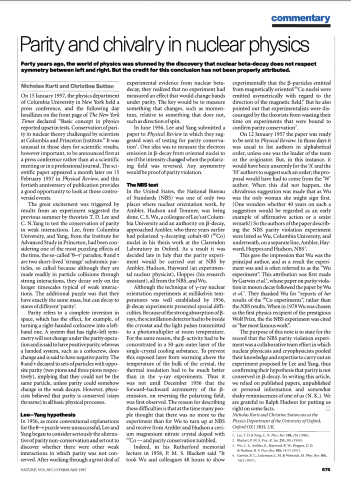Parity and chivalry in nuclear physics

On 15 January 1957, the physics department of Columbia University in New York held a press conference, and the following day headlines on the front page of The New York Times declared "Basic concept in physics reported upset in tests. Conservation of parity in nuclear theory challenged by scientists at Columbia and Princeton Institute." It was unusual in those days for scientific results, however important, to be announced first at a press conference rather than at a scientific meeting or in a professional journal. The scientific paper appeared a month later on 15 February 1957 in Physical Review, and this fortieth anniversary of publication provides a good opportunity to look at those controversial events.
On 12 January 1957 the paper was ready to be sent to Physical Review. In those days it was usual to list authors in alphabetical order, unless one was the leader of the team or the originator. But, in this instance, it would have been unseemly for the 'A' and the 'H' authors to suggest such an order; the proposal would have had to come from the 'W' author. When this did not happen, the chivalrous suggestion was made that as Wu was the only woman she might sign first. (One wonders whether 40 years on such a suggestion would be regarded as an early example of affirmative action or a sexist remark!) So the authors of the paper describing the NBS parity violation experiment were listed as Wu, Columbia University, and underneath, on a separate line, Ambler, Hayward, Hoppes and Hudson, NBS.
This gave the impression that Wu was the principal author, and as a result the experiment was and is often referred to as the "Wu experiment". This attribution was first made by Garwin et al., whose paper on parity violation in meson decay followed the paper by Wu et al. They thanked Wu for "reports of her results of the Co60 experiments': rather than the NBS results. When in 1978 Wu was chosen as the first physics recipient of the prestigious Wolf Prize, the the NBS experiment was cited as "her most famous work':
The purpose of this note is to state for the record that the NBS parity violation experiment was a collaborative team effort in which nuclear physicists and cryophysicists pooled their knowledge and expertise to carry out an experiment proposed by Lee and Yang, thus confirming their hypothesis that parity is not conserved in β-decay